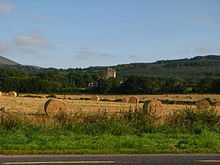Kilcash Castle
| Kilcash Castle | |
|---|---|
|
Kilcash Castle ruin | |
| Location | 5 miles (8 km) east of Clonmel, County Tipperary, Ireland |
| Coordinates | 52°23′52″N 7°31′17″W / 52.39778°N 7.52139°WCoordinates: 52°23′52″N 7°31′17″W / 52.39778°N 7.52139°W |
| Built | 16th century |
 Location of Kilcash Castle in Ireland | |
Kilcash Castle is a ruined castle off the N24 road just west of Ballydine in County Tipperary, Ireland. The castle is currently ruined and is in the care of the Irish State. The Butler dynasty has important links to the area.
History

The main castle building is a fortified tower dating from the sixteenth-century. An adjoining hall was added at a later date, when the need for defence gave way to the large windows associated with settled times.[1] In the sixteenth century the manor of Kilcash passed from the Wall family into the possession of the Butlers of Ormond until the latter sold it to the Irish State in 1997 for £500.[1]
The castle was visited by James Tuchet, 3rd Earl of Castlehaven, a noted Confederate Catholic commander in the 1641-52 war, who wrote his memoirs at Kilcash where his sister, Lady Frances, was married to another Confederate commander, Richard Butler of Kilcash (d. 1701).[1]
In the 19th century, the castle fell into ruin after parts of the Kilcash estate were sold c. 1800. During the Irish Civil War, the castle was occupied by anti-treaty forces in an attempt to slow the approach of pro-treaty forces towards Clonmel. They were finally dislodged by artillery fire under the command of General Prout, further damaging the already dilapidated structure.[2]
By the late twentieth century the castle was in a dangerous state of repair. It is currently undergoing extensive repairs which will prevent it from collapsing.[3]
Near the castle are the remains of a medieval church with a Romanesque doorway. This building was partially repaired in the 1980s and is now safe to visit. In the graveyard, the mausoleum (a building nearly as large as the church) contains the tombs of Archbishop Christopher Butler (1673–1757), Margaret, Viscountess Iveagh (see below), Walter Butler, the 16th Earl of Ormond (d. 1773) and John Butler, the 17th Earl (d. 1795).[1] Some of the eighteenth-century headstones are carved with elaborate scenes of the crucifixion.
Lament for Kilcash
The castle is best known for the song "A Lament for Kilcash" (Irish: Cill Chais) which mourns the death of Margaret Butler, Viscountess Iveagh (d. 1744), who, after the death of her first husband, married to Colonel Thomas Butler of Kilcash (d. 1738). The song was traditionally ascribed to Fr John Lane (d. 1776) but the woods lamented in its first stanza were not sold until 1797 and 1801, long after Lane's death.[1] The earliest manuscripts of the poem date from the mid nineteenth century. Its first stanza reads:

- Cad a dhéanfaimid feasta gan adhmad?
- Tá deireadh na gcoillte ar lár;
- níl trácht ar Chill Chais ná ar a teaghlach
- is ní chluinfear a cling go bráth.
- An áit úd a gcónaíodh an deighbhean
- fuair gradam is meidhir thar mhnáibh,
- bhíodh iarlaí ag tarraingt tar toinn ann
- is an t-aifreann binn á rá.
- Now what will we do for timber,
- With the last of the woods laid low?
- There's no talk of Cill Chais or its household
- And its bell will be struck no more.
- That dwelling where lived the good lady
- Most honoured and joyous of women
- Earls made their way over wave there
- And the sweet Mass once was said.
(translation by Eiléan Ní Chuilleanáin)
References
| Wikimedia Commons has media related to Kilcash Castle. |
- ↑ 1.0 1.1 1.2 1.3 1.4 John Flood and Phil Flood, Kilcash: A History, 1190-1801 (Dublin: Geography Publications, 1999), 27. ISBN 978-0-906602-66-9
- ↑ Tillinghast, Richard (2008). Finding Ireland: a poet's explorations of Irish literature and culture. University of Notre Dame Press. p. 270. ISBN 978-0-268-04232-5. Retrieved 2011-04-12.
- ↑ Kiely, Jacinta (2011). "Database of Irish excavation reports - Tipperary 2007:1685 Kilcash Castle 23263 12734 TS078–037 E2018". Department of the Environment, Heritage and Local Government. Retrieved 16 April 2011.

